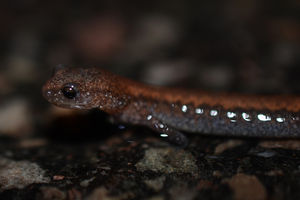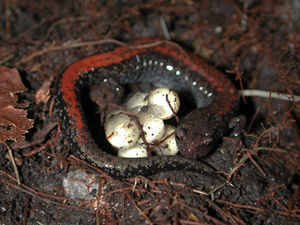Eastern red-backed salamander

General Description
Plethodontidae is the family that the eastern red-backed salamanders are classified in, as they are lungless. Oxygen dissolves into the moisture on their skin and then the oxygen is absorbed into the skin. It is vital for them to maintain their moisture, without it they cannot breathe. It should also be noted that one should not physically handle a salamander for long period of time as they can lose that moisture.
These salamanders come in two different color phases, the first being the lead-back, and the other being the red-back. The red-backed phase is the usual coloring of reddish orange along the back. Lead-backs have a dark grey to black coloring over their body and are much less commonly found. Adults will reach about 2-5 inches in length.

Geographic Distribution & Habitat
The Eastern red-backed salamander can be found all the way south to North Carolina, westward to Ohio and northward into New England through Nova Scotia. There are a variety of forest types where they can be found, ranging from deciduous to coniferous. The species of this species prefers moist soils, and will usually avoid dry, sandy soils and floodplains. During the cooler months, namely October to March, they tend to move underground. [1] The Eastern red-backed salamander is more likely to be found in areas containing neutral or basic soils rather than areas containing high acidity. Like most salamanders, they are typically found hidden under logs, leaf litter, and rocks during the day as they are most active at night. [3]
Ecology
Their role in the soils ecosystem is vitally important, especially in regards to the fungal community. Fungus plays an essential role in the nutrient cycling of forests, without them the organic matter would not be broken down as quickkly. Many invertebrates such as mites, beetles, centipedes, and snails feed upon fungus as a source of nutrition. The eastern red-backed salamanders ensure a balance is kept by feeding on them, thus, controlling the populations of these insects [2]. The eastern red-backs not only indirectly influence the volume of fungus present but also the diversity of fungus in the ecosystem as well.
Based on the 2002 study by Jaeger et al, 1 square kilometer can be home to 3 million eastern red-backed salamanders. It is estimated that their population outnumbers all birds and mammals in that area combined, they may be the most populous vertebrate in the north-eastern forests [2]. They are preyed upon by larger salamanders, birds, snakes, and mammals [1]. To escape said predators, they have the ability to detach their tail, the tail will wiggle after detached allowing the salamander to run away. It will then regrow a new tail over time [1]. Eastern red-backed salamanders are fairy tolerant to habitat disturbance as long as they key components are maintained, that being leaf litter, fallen logs, rocks, ect. [1]

Reproduction & Growth
Mating season for eastern red-backs begins in sometime between October through December. Males will follow the pheromone trails left by the females. The courtship initiates with the male rubbing his head on the female's snout. After the rubbing has ceased the male then deposits the spermatophore and the female retrieves it with her cloaca.
A very large amount of energy is required for the females to produce their eggs, so it is thought that they only breed once every other year. She lays her eggs sometime in the summer. Most amphibians will leave their eggs after they have been laid but the female salamander remains with them until hatching occurs. Since dehydration of eggs can occur easily she will wrap herself around them to ensure they stay moist, she will only eat when opportunity presents itself. [2]. Eggs then hatch two months later in August or September, the hatchlings will remain with the mother for a few weeks after hatching. [2] Maturity is reached in about two years and females usually lay their first clutch at three years old.
References
[1] Harding, J. & Mifsud, D. "Amphibians & Reptiles of the Great Lakes Region". University of Michigan Press, 2017. pg 91-95
[2] Clark,E. "Essential ubiquity: "How one tiny salamander species has a huge impact" Mongabay Series: Salamanders, 21 December 2018
[3] AmphibiaWeb. 2021. <https://amphibiaweb.org> University of California, Berkeley, CA, USA.
[4] Eastern red-backed salamander photographed by Larry Clarfeld on April 26th, 2018 from iNaturalist
[5] Robert G. Jaeger, Jennifer R. Gillette, Robert C. Cooper, Sexual coercion in a territorial salamander: males punish socially polyandrous female partners, Animal Behavior, Volume 63, Issue 5, 2002, Pages 871-877, doi:10.1006/anbe.2001.1977.
[6] Female eastern red-backed salamander guarding her eggs, photograph from https://www.amphibianfact.com/red-backed-salamander.asp
[7] Distribution map from Harding, J. & Mifsud, D. "Amphibians & Reptiles of the Great Lakes Region". University of Michigan Press, 2017. pg 92